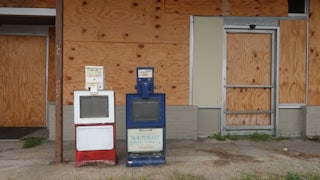Over the summer, Democratic legislative successes coupled with dropping gas prices worked to drive attention away from the precarity of the economy. Meanwhile, rage continued to seethe at the Supreme Court’s abrogation of reproductive rights. Signs were pointing in the right direction for Democrats heading into the fall midterms.
But polls are tightening in critical swing elections. A recent Siena/New York Times poll found a massive swing toward Republicans among independent women. And it all goes back to inflation—which was, along with “the economy,” rated the most important issue facing the country. Last week’s consumer price index showed just how stubborn inflation can be, sustaining at 8.0 percent year on year.
But when voters name inflation as their top political issue, it would be absurd to assume they’re talking about the economic phenomenon by which currency loses value because of a mismatch in supply and demand. Rather, they mean the specific way rising prices affect them. And that’s not just one thing—it’s many things depending whom you’re talking to. Beyond addressing inflation itself, the political response to inflation has to address the broadest, deepest manifestations of inflation on American voters. That requires answering a psychological question wrapped around an empirical one. What aspect of “inflation” is the biggest, most common, and most consistent? It isn’t the price of gas. It is—by far—housing.
So as we head into the midterms, Democrats would do well to talk more about housing. After all, median asking rent in America is over $2,000 for the first time in our history—up more than 15 percent since last year. That’s driven, in part, by millions of Americans who’ve been priced out of buying as interest rates skyrocket because of the Federal Reserve’s interest rate hikes. The average size of a new mortgage also set a record: $453,000. Those would-be buyers are being forced into an already overheated rental market.
It’s not just that the price of housing is so high. It’s that feeling its pinch is almost inevitable. To appreciate what I mean by this, consider two aspects of inflation that have gotten a lot more attention. Buying a new car (even if it is used) is a lot more expensive today than it was last year. But you don’t have to buy a new car—if it’s too expensive, you can hold out and drive the old one a bit longer. Gas, on the other hand, is a weekly—sometimes even more regular—expense for most Americans. The cost of a full tank is $50, maybe $100 at the high end. That may be annoyingly high, but it’s far from the biggest expense on most household budget sheets. Rent or mortgage payments are. And because rental contracts renew most years—and because more homeowners are choosing adjustable-rate mortgages—housing costs are quite sensitive to inflation-induced price hikes. A look at the most recent consumer price index for September shows that the cost of shelter is among the fastest-growing line item on the American budget.
But the folks pinched hardest by our housing market are the ones who are left out of it. Homelessness is near an all-time high—and the encampments in every major metro in the United States are proof. Nowhere is this more obvious than on the West Coast, where housing has factored as one of the most important issues in Los Angeles’s upcoming mayoral elections.
And housing is about more than just shelter. It’s also about wealth accumulation. Owning a home remains the most important long-term investment the average American family can make. But more young Americans are finding that investment out of reach. By the age of 30, only about 42 percent of millennials owned a home. That compares to 48 percent of Generation X and 51 percent of Baby Boomers. And no, it’s not because we’ve spent too much on cold brew and avocado toast. It’s because we’re being priced out.
It turns out that the down payment on a mortgage is where skyrocketing college debt and generational inequality conspire to lock millennials out. It’s not just that younger generations couldn’t rely on the subsidized college educations that older generations took advantage of (and then foreclosed upon). It’s that they are increasingly competing for the very same homes with their wealthier elders looking to downsize or pick up an investment property.
Oh, and don’t forget that it was a housing bubble that caused the last recession. Housing sits and has always sat at the leading edge of America’s economy. The question now is whether Democrats are willing to talk about it. Too often, political discussions of the economy get overly wonky, overly fast. People check out when they feel like your solutions don’t speak to their problems. But by specifically name-checking housing with clear proposals about how to address it, Democrats can offer direct solutions that match direct challenges.
For its part, the Biden administration’s focus on housing has come in the form of a “Housing Supply Action Plan,” a series of administrative adjustments designed to reduce housing costs and spur affordable new constructions. These are positive, though modest, steps. Housing hasn’t factored as high on the list of the administration’s legislative priorities. But if the president wants to keep his majorities for the next two years, it should be. Right now, President Biden’s approval is weighing down heaviest among young people—but then, so is their rent. Perhaps doing something about it might help.






